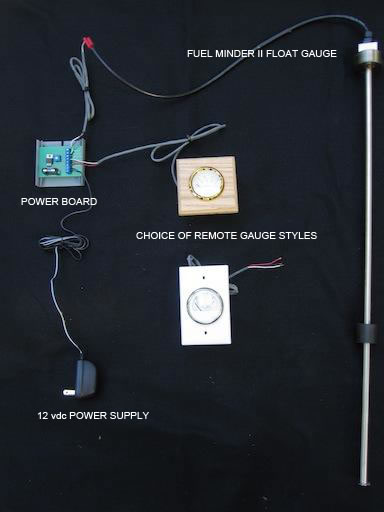
the fuel minder™ store
Your # 1 Source for remote fuel-level indicators and accessories!
Tools Needed: flat head screwdriver,wire cutters/strippers, channel lock pliers, 2 3/8" hole saw or keyhole saw, a staple gun for small gauge wire, measuring tape, and vise grip pliers.
Before you begin: Here are some initial factors to consider
to make sure your installation goes smoothly. Determine a suitable mounting location for the power board. Choose one which is in close proximity to a 110 volt outlet, the oil tank, and to where you will be mounting the remote gauge. This alleviates the time spent running excess wire. Choose a location for the remote gauge which will be easy to fish a wire to, e.g. within an interior wall near the existing thermostat where a hole for the wire may already exist.
| A. Remove existing gauge or remove plug from tank opening. | B. Insert sending unit into tank and thread in to tighten. If using adapter, thread on adapter to sending unit prior to insertion into the tank, then thread in the unit into the tank. Tighten using channel lock pliers. |
| C. Connnect wires from sending unit to hookup wire black and white wires using crimp terminals provided | D. Run wire to power board and connect to power board "sending unit signal" and "send unit com" |
| A. Check for studs, electrical wiring or plumbing pipes in the location where you will be drilling. Mark and measure for hole, be sure to leave two inches on each side of the hole to accommodate the bezel. Make a 2 3/8" hole. Do not place in an exterior wall. Use an interior wall where there is no insulation or sill plates to contend with. To fit into the decor, the gauge should be mounted at a level which is conducive for ease of reading. |
 |
| B. Drill a 1/2" hole in the basement directly under the center of the remote gauge opening. An easy way to determine where this is, is to use a locator bit. This is a bit which is long and very small in diameter. Attach this to your drill and drill down in line with the center of the gauge opening as close to the wall as possible. Go downstairs and find the locator bit. Measure in the distance from the bit to the center of the inside of the wall, taking into consideration the width of the sheet rock or paneling which covers the wall then drill up into the wall. | C. Fish the wire up to the remote gauge opening. Take a piece of string with a weight on it (a 2oz fishing weight works well) and drop it from the remote gauge opening into the wall jigging it till it hits the wall plate below. Sometimes if you are lucky, it will fall through the hole below and will null the next step. Take a piece of fish tape with a hook on it and insert it into the 1/2" hole from below to catch the string and pull it through the hole. Attach your 22 gauge wire to the string and pull it up through the remote gauge opening. Run the wire from the gauge to the power board and connect it to the appropriate terminals. |
| D. Make sure all your wiring connections are correct before plugging in the transformer. Connect the transformer wire from the power board to the 12 volt transformer and plug it into the 110 volt outlet. |
 |
E. View the remote gauge and make sure it is reading the fuel level in the tank. D. If the reading does not match with the fuel level in the tank, adjust the zero adjust potentiometer up or down to make the remote gauge read correctly. E. If the readings above are normal, you now can permanently mount the remote gauge. Mount the remote gauge to the wall with supplied screws.
TROUBLESHOOTING The Fuel Minder II™ No reading on the gauge: Check and make sure you have 12 Volts DC coming into the power board from the transformer. Make sure transformer is secured into the outlet.
|